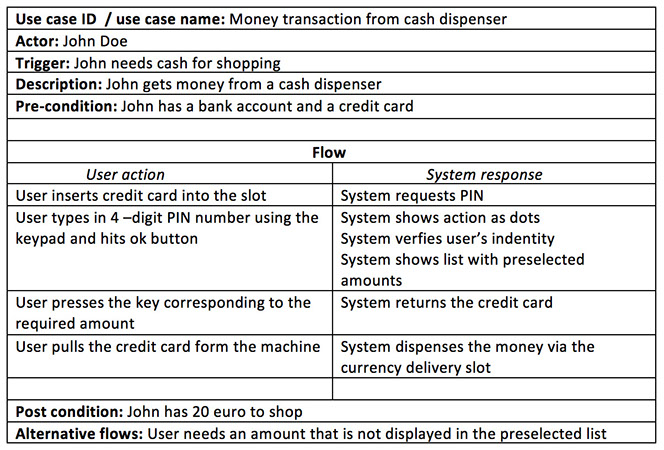Scenarios
As said before, a scenario is a story with an actor that performs a certain task. It is a narrative description with a clear beginning and ending of a sequential set of actions. It helps to further define a concept.
What
A scenario is a story with a actor that performs a certain task. It is a narrative description of a sequential set of actions performed in a certain context.
Use when
You can use scenarios in different stages of the design process. You can use scenarios about a present situation to understand what people do and what the want. You can generate ideas and specify new requirements when writing a scenario. You can evaluate a design concept in a scenario that describes how certain features of a prototype apply under a certain circumstance.
Why
They are useful in understanding, envisioning, conceptualizing and evaluating requirements and concepts during a design process.
How
There are different types of scenarios:
Concrete Scenario (envision and evaluate ideas and specify requirements)
Concrete scenarios contain more specific elaborations of a design solution. In a concrete scenario you can evaluate a concept, describe concrete requirements, explore possible features and even include ideas about the interface. In a way a concrete scenario’s is exploration of a concept that will give you an idea of the feasibility of a, yet to be realized, system or solution.
Source: 'Designing Interactive Systems', David R. Benyon 2013
Use Case Description
A use case focuses on user-system interaction. Although the focus is on the user and the software system the emphasis is still very much on the user’s perspective. Utilize use cases to validate specifications, optimize requirements and establish every step in a user-system interaction. Describe the user action and the system response in detail.
Source: 'Interaction Design, Beyond human - computer interaction', Yvonne Rogers & Jenny Preece 2015.
In general a use case description contains the following items:
- Use case ID / use case name
- Actor (the user)
- Trigger (what triggers the use case?
- Description (short description of the task)
- Pre-condition (are there any pre conditions that should be met before the execution of the use case can start?)
- Normal flow (all user actions and system responses described in detailed steps)
- Post-condition (what will be the result?)
- Alternative flows (what exceptions can influence the flow?)
Examples
This is an example of a use case description:

Assignment
Part 1 Concrete Scenario
Write a concrete scenario that elaborates on your design solution and takes the context into account.
Describe a task that is supposed to be executed with your app/website:
- Describe the actor(s): who is it?, how old?, computer skills? etc.
- Describe the room / space where the task is executed: are there any environmental conditions that will influence the execution of the task?
- Describe why a user is motivated/triggered to perform this task
- Describe the interaction with the website/ app
- Describe interaction between actors
- Describe any problems/issues that occur during the execution of the task
- Divide your page in two columns. Write your scenario in the first column, write requirements the are needed to execute the task in the second column
Part 2 Use Case Description
Zoom in by making 3-4 use case descriptions of different relevant tasks of your scenario (one per Design Team member). This should give you the starting point for making your list of requirements.
After these steps, check the user story list. Add and/or adjust stories if necessary.
Tutorials and Talks
Further Reading
No further reading